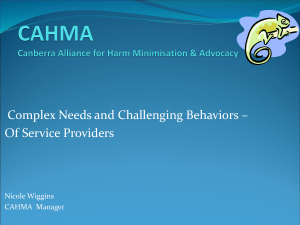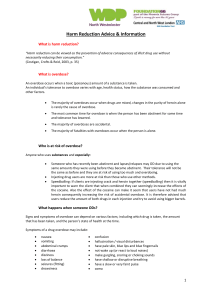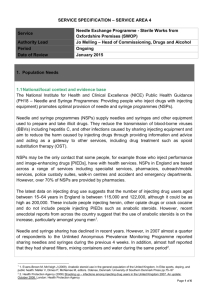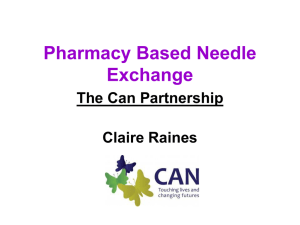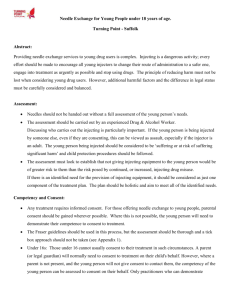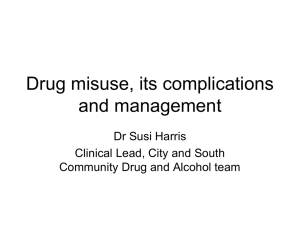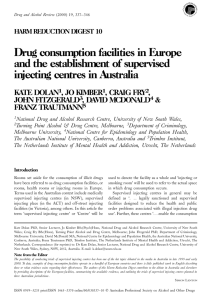Foil: Needle Exchange, Harm reduction, Reducing Drug Related
advertisement
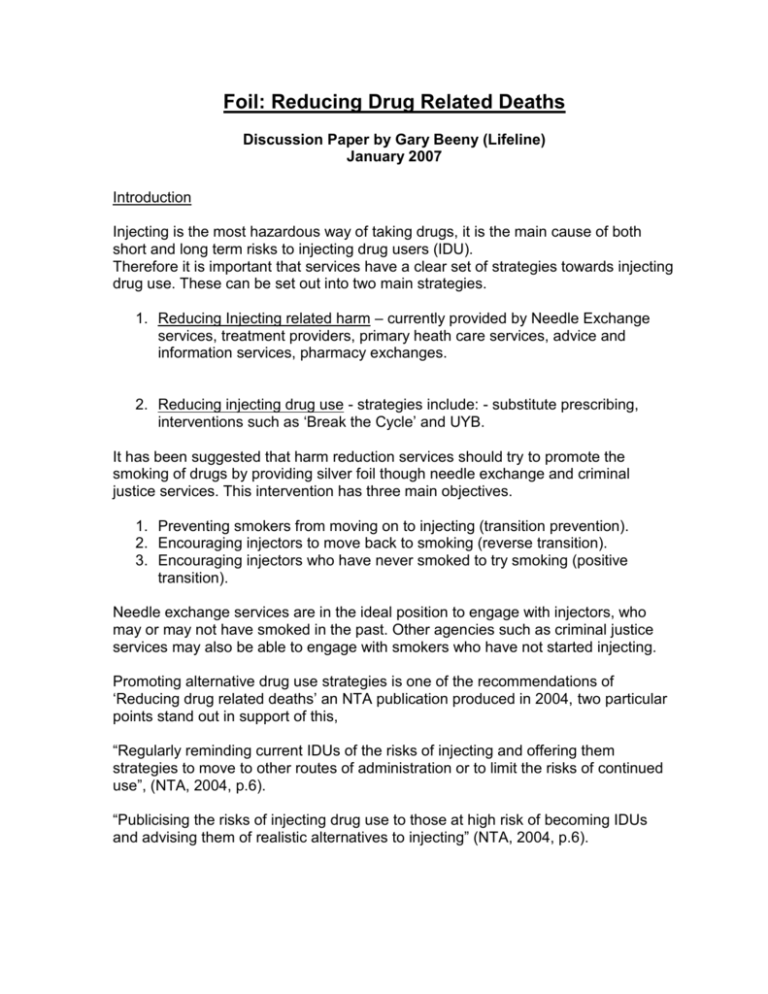
Foil: Reducing Drug Related Deaths Discussion Paper by Gary Beeny (Lifeline) January 2007 Introduction Injecting is the most hazardous way of taking drugs, it is the main cause of both short and long term risks to injecting drug users (IDU). Therefore it is important that services have a clear set of strategies towards injecting drug use. These can be set out into two main strategies. 1. Reducing Injecting related harm – currently provided by Needle Exchange services, treatment providers, primary heath care services, advice and information services, pharmacy exchanges. 2. Reducing injecting drug use - strategies include: - substitute prescribing, interventions such as ‘Break the Cycle’ and UYB. It has been suggested that harm reduction services should try to promote the smoking of drugs by providing silver foil though needle exchange and criminal justice services. This intervention has three main objectives. 1. Preventing smokers from moving on to injecting (transition prevention). 2. Encouraging injectors to move back to smoking (reverse transition). 3. Encouraging injectors who have never smoked to try smoking (positive transition). Needle exchange services are in the ideal position to engage with injectors, who may or may not have smoked in the past. Other agencies such as criminal justice services may also be able to engage with smokers who have not started injecting. Promoting alternative drug use strategies is one of the recommendations of ‘Reducing drug related deaths’ an NTA publication produced in 2004, two particular points stand out in support of this, “Regularly reminding current IDUs of the risks of injecting and offering them strategies to move to other routes of administration or to limit the risks of continued use”, (NTA, 2004, p.6). “Publicising the risks of injecting drug use to those at high risk of becoming IDUs and advising them of realistic alternatives to injecting” (NTA, 2004, p.6). Advantages of Smoking Drugs Compared with Injecting Eliminates the risk of contracting Hep B, Hep C, and HIV. Eliminates the risk Abscesses, Thrombosis (vein collapse), Deep Vein Thrombosis (DVT), Gangrene, Fungal Infections, Septicaemia, Endocarditis, Pulmonary Embolism (PE), Ulcers, Cellulitis, Phlebitis, Arterial damage, Dirty / Bad hits, problems associated with missed hits. Seriously reduces the risk of overdose (although still possible) when compared to injecting. Target Group Although all needle exchange clients would benefit from switching to smoking from injecting, there are particular clients who could be targeted for this intervention. Clients recently detoxed or recently finished treatment. Clients recently released from Prison. Clients with irregular patterns of drug use (not regular injectors). Clients recently discharged from Hospital. In essence clients assessed to be at risk of overdose. Additional benefit may be gained by supplying foil to clients who were having problems injecting. These clients include; Clients who had run out of surface vein injecting sites that were thinking of injecting into deep veins. Clients who had a history of deep vein injecting who were having health problems associated with this type of use (DVT etc). Clients who have run out of the common injecting sites and are thinking of using high-risk sites like the jugular, penis or breasts. Potential Problems Supplying foil to clients could be problematic for a number of reasons, these are outlined below 1. Legal implications On August 1st 2003 section 9(a) of the misuse of drugs act was amended so that needle exchange services were able to supply more items of injecting paraphernalia, this was done to bring the law into line with current needle exchange practise with the aim of protecting drug workers from criminalisation. Providing foil may well be illegal in the strictest terms of this section of the Misuse of Drugs Act but, however, it could be argued that providing this intervention does not challenge the ‘spirit’ of a law that was initially designed to restrict shops providing Cocaine Kits in the 1980’s. 2. Encouraging behavioural change The most difficult aspect of this intervention will probably be trying to persuade people to change their behaviour around injecting, the success of this intervention will rely very heavily on drug workers ability to engage with and interact with clients, anecdotally, Lifeline workers have been engaged in some preliminary discussions with clients with fairly positive results, we found that clients were quite open to the idea of testing out their tolerance to opiates by smoking before commencing injecting after a break, we also found in two cases that the clients were thinking about giving up injecting anyway and they would be very receptive to the idea of smoking as a transitional stage in the process of stopping altogether. Most thought it was a good idea to have it as an option even if they didn’t plan to use it. Interestingly, many thought that needle exchange workers should spend more time encouraging people to stop injecting. 3. Overdose Risk Smoking heroin still represents a risk of overdose, particularly if a client has recently consumed other depressant drugs such as Benzodiazepines, Alcohol or Methadone, however, when compared to injecting, smoking may be a lot less risky as it is very difficult to smoke when experiencing the sedating effects of depressant drugs. A drug user can titrate their own dose more safely than if they inject the whole amount of heroin in one dose. Drug workers that dispense foil should make an ‘overdose risk assessment’ by making a brief assessment of recent drug use and assessing tolerance by discussing significant breaks in use. This is standard practise in needle exchange settings when dispensing sterile injecting equipment. Training Clients who have never smoked or have not smoked for some time may need some guidance on how to smoke from foil. It may be useful to have some information available and for workers to be able to discuss the technique of smoking from foil. The technique and harm reduction benefits are discussed in the publication ‘Smoking Brown’, by Lifeline Publications.
